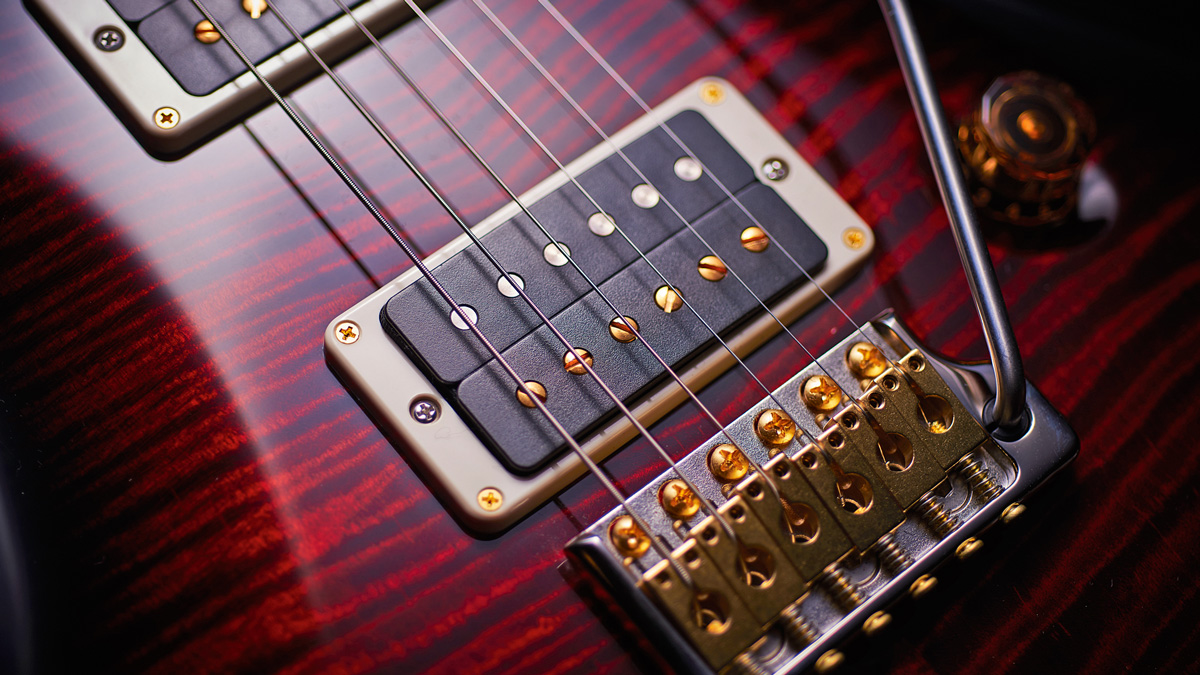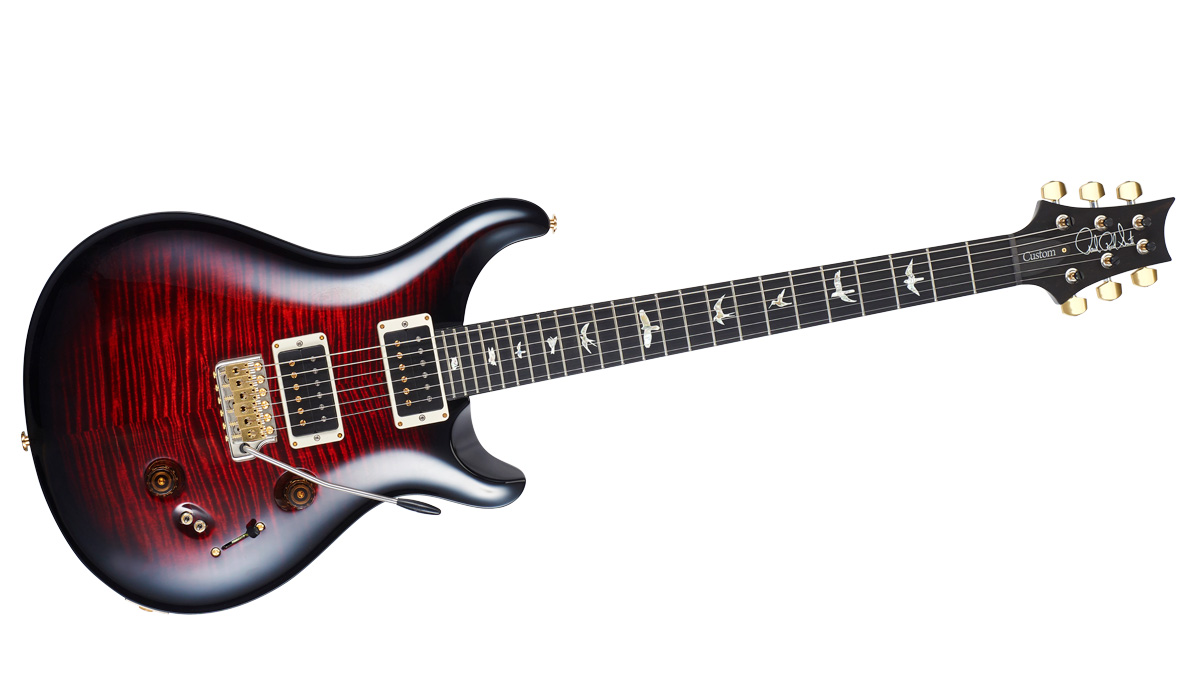MusicRadar Verdict
The choice over which Custom you buy is up to you of course, but whichever one you select you’ll be buying into, arguably, the only real progression of the electric guitar since about 1965.
Pros
- +
Excellent build, playability and genre-hopping sounds with expanded single coil voices.
Cons
- -
Expensive, limited options, no lefties.
- -
Does the pickup switching really justify its own model?
MusicRadar's got your back
It’s a question we get asked a lot: which PRS guitar is right for me?
Certainly if your budget stretches to the £3k and upwards USA-made Core line it’s even more important to find the right model. If we zone in on the classic double-cut shape, with vibrato and without piezo, there are seven: the Custom 24 and 22, plus the Custom 24 Floyd, the 408, 509, Paul’s Guitar (the only model with optional Stoptail or vibrato) and the David Grissom DGT signature.
They all share the same outline (the 509 being very slightly different), the same 635mm (25”) original scale length - with the exception of the 509’s 641mm (25.25”) - with 22 frets, aside from the Custom 24s, and dual humbuckers with a master volume (only the DGT has individual volume controls) and a master tone.
The differences primarily lie in the pickups: the Customs have uncovered 85/15s (with the exception of the Custom 24 Floyd which uses the uncovered \m/ humbuckers); the 408 has its eponymous larger bridge and smaller neck humbuckers; Paul’s Guitar goes for two of the smaller 408 neck humbuckers. The 509 has the 513-style five single coils, and the DGT offers David Grissom’s own-blend covered ‘buckers. As of November 2017, we have another Core option, the Custom 24-08.

The 24-08 first appeared back in 2016 as a 50 piece-only limited run released at the time of PRS’s in-house Experience event and you’ll find numerous subsequent dealer-ordered ‘Wood Library’ versions available. Our review model comes from that latter camp although it’s identical to the new standard Core model but to bypass the new CITES legislation has an ebony, as opposed to the standard model’s rosewood, fingerboard.
The 2017 Custom 24 has certainly evolved from its original 1985 specification with virtually every part being constantly re-evaluated and improved over the years. It retains that outline and original 49mm depth - the thinnest Core model. Aside from the ‘08’ part, the other new feature for this year is the Gen III vibrato which now replaces the long-running second generation version on all the Core models with the exception of the Custom 24 Floyd.
While there’s a pretty big range of eye-catching colour V12 finishes, options are limited. You can choose neck shape - either pattern regular or pattern thin (as here) which to old-school PRS players are pretty similar to the previous regular and wide-thin shapes - and a figured maple 10 top (as here, which defaults to hybrid gold/ nickel hardware over the non-10-top’s nickel).
Then there’s the Artist Package option which adds a more significant outlay. But simple things like dot inlays instead of the ubiquitous birds or gold hardware, let alone a left-handed version, are not offered.
Feel and sounds
Pulling a current-spec Custom 24 from its weighty hard case you can’t help but be impressed by the craft. Yes, of course, the cost means you shouldn’t expect anything less, but production guitar-making doesn’t get better than this. It is beautifully weighted, feels like a supermodel and so long as the aesthetic appeals, you’ll find it’s a guitar for life.
By design, it sits between the two generic landmarks, the Gibson Les Paul and the Fender Stratocaster, both in build style and the sounds we hear. There’s less bulk, in feel and sound, compared to a single-cut and while there’s something of the Strat’s feel in the lighter weight and strapped on feel (although the neck feels longer despite the shorter 25-inch scale) the sonic selections are more Gibson than Fender.
So what does the 24-08 bring to the table? Well, unlike the standard Custom’s wiring, you can run the Custom 24-08 as, for example, a pretty convincing single coil guitar: neck, both and mixed. You’ll notice the neck pickup is reversed so that the primary coils, the slug coils, both face the neck creating a very woody character at neck and a fuller, less spiky voice at the bridge.
The mini-toggles are faster than trying to pull up the tone control electronics
Does it nail a Strat’s voice? Both the solo neck or bridge single coils sound a little more ‘humbucking’, a little smoother in the highs and thicker in the lower mids and lows: less choppy. You can narrow the gap with a little volume reduction and, of course, the bridge and neck combination has wider spaced coils than a Strat: it’s more Tele-ish if we’re honest.
There’s only one sound on the Custom 24 to directly compare with, that’s the bridge and neck single coil mix which, with its closer placement of the two slug coils, sounds a little more Strat-mix-like than the 24-08 which sounds wider, less ‘quacky’ and less thin and bright.
But certainly if you want that single coil-like clarity and harmonic detail, from both the neck or bridge, which you can’t get on the standard Custom, it’s here. You might want the full ‘bucker at bridge then switch to the neck in single coil for a cleaner, more defined sound - or indeed vice versa. There is also very little volume drop, too, between the two modes.
It’s hard to see how PRS can better the ‘do-it-all’ Custom 24
Yet running the 24-08 as a ‘Gibson’ in humbucking mode it again hints at all sorts of references especially as we kick in various pedals. In fact, the modern pedalboard culture has influenced the pickups PRS is making. “As pedalboards get more extensive,” says Paul, “PRS guitars get clearer and cleaner. It’s not the driver for me but it’s the driver for the market.
“Look, it’s difficult to have a very clear sounding pickup that doesn’t sound like an ice-pick and as we learn how to do that, we apply it. So, high-end is never the problem, beautiful high-end is not the problem: it’s ice-pick high end that’s the problem and every time we learn how to get a more musical, less ice-pick, high end we do it.”
And we didn’t hear that ice-pick at all. Clarity, yes, from either the single coil or the quite clear, classic output of the humbuckers. It’s part of the modern PRS recipe.
Unlike the preset sounds of the standard Custom, the 24-08’s mini-toggles are a little faster than trying to pull up the tone control of the McCarty electronics - you can also split the pickups individually, not just simultaneously - but you do have, potentially, two moves to make: the three-way lever and the specific pickup mini toggle. It’s a different drive.
It’s hard to see how PRS can better the ‘do-it-all’ Custom 24. No, it’s not - and never has been - a replacement for your Les Paul or Stratocaster: its validity lies in its ‘duality’, mixing elements of both. It’s tuned to the highest level too: stage-ready with more than enough sounds to get you through a huge range of styles and gigs.
On top of that, this new 24-08 gives us three more sounds - bridge single coil, neck single coil and neck humbucker with bridge single coil - and edges the Custom into a more Fender-y camp yet is far from a ‘Fender’... or indeed anything else. It remains, 32 years on, a PRS.
The choice over which Custom you buy is up to you of course, but whichever one you select you’ll be buying into, arguably, the only real progression, and a constantly evolving one at that, of the electric guitar since about 1965.
Dave Burrluck is one of the world’s most experienced guitar journalists, who started writing back in the '80s for International Musician and Recording World, co-founded The Guitar Magazine and has been the Gear Reviews Editor of Guitarist magazine for the past two decades. Along the way, Dave has been the sole author of The PRS Guitar Book and The Player's Guide to Guitar Maintenance as well as contributing to numerous other books on the electric guitar. Dave is an active gigging and recording musician and still finds time to make, repair and mod guitars, not least for Guitarist’s The Mod Squad.
“Every one of them said yes without hesitation": Hank Marvin and Roger Taylor have just remade a '60s classic for charity
Do you know where your money goes when you buy a gig ticket? A new report breaks it down
“Every note counts and fits perfectly”: Kirk Hammett names his best Metallica solo – and no, it’s not One or Master Of Puppets











